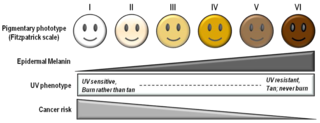Fitzpatrick scale

The Fitzpatrick scale (also Fitzpatrick skin typing test; or Fitzpatrick phototyping scale) is a numerical classification schema for human skin color. It was developed in 1975 by American dermatologist Thomas B. Fitzpatrick as a way to estimate the response of different types of skin to ultraviolet (UV) light.[2] It was initially developed on the basis of skin color to measure the correct dose of UVA for PUVA therapy, and when the initial testing based only on hair and eye color resulted in too high UVA doses for some, it was altered to be based on the patient's reports of how their skin responds to the sun; it was also extended to a wider range of skin types.[3][4][5] The Fitzpatrick scale remains a recognized tool for dermatological research into human skin pigmentation.
The following table shows the six categories of the Fitzpatrick scale in relation to the 36 categories of the older von Luschan scale:[6][7][8]
| Fitzpatrick type | von Luschan scale | Characteristics |
|---|---|---|
| I | 0–6 | always burns, never tans (palest; freckles) |
| II | 7–13 | usually burns, tans minimally (light colored but darker than pale) |
| III | 14–20 | sometimes mild burn, tans uniformly (golden honey or olive) |
| IV | 21–27 | burns minimally, always tans well (moderate brown) |
| V | 28–34 | very rarely burns, tans very easily (dark brown) |
| VI | 35–36 | never burns (deeply pigmented dark brown to darkest brown) |
Emoji modifiers
[edit]The Fitzpatrick scale is also the basis of skin color in emoji, with five modifiers according to the Fitzpatrick scale (types I and II merged).
Eurocentric bias
[edit]The Fitzpatrick scale has been criticized for its Eurocentric bias and insufficient representation of global skin color diversity.[9] The scale originally was developed for classifying "white skin" in response to solar radiation,[2] and initially included only four categories focused on white skin, with "brown" and "black" skin types (V and VI) added as an afterthought.[3]
The scale's methodology, relying on self-reporting of skin color, sunburn, and sun tanning response, fails to capture the broad spectrum of skin reflectance. Studies demonstrate that European populations have the narrowest skin color variation, whereas groups categorized as 'brown' or 'black' exhibit a much wider range.[10][11]
The efficacy of the Fitzpatrick scale even among white-skinned individuals has been argued to be questionable,[9] since studies such as that on a Dutch student population[12] have found it inadequate for categorizing, challenging its appropriateness for investigating the relationship between sunburn tendency and tanning ability.[9]
The Fitzpatrick scale's Eurocentric orientation and its limitations in accurately representing global skin color diversity, along with similar biases in classifying other phenotypic traits, have been argued to require more inclusive and scientifically valid categorizations in dermatological and genetic research.[9]
See also
[edit]References
[edit]- ^ D'Orazio, John; Jarrett, Stuart; Amaro-Ortiz, Alexandra; Scott, Timothy (7 June 2013). "UV Radiation and the Skin". International Journal of Molecular Sciences. 14 (6): 12222–48. doi:10.3390/ijms140612222. PMC 5. PMID 23749111.
- ^ a b Fitzpatrick, T. B. (1975). "Soleil et peau" [Sun and skin]. Journal de Médecine Esthétique (in French) (2): 33–34
- ^ a b Fitzpatrick, T.B. (1988), "The validity and practicality of sun-reactive skin types i through vi", Archives of Dermatology, 124 (6): 869–71, doi:10.1001/archderm.1988.01670060015008, PMID 3377516
- ^ Pathak, M. A.; Jimbow, K.; Szabo, G.; Fitzpatrick, T. B. (1976). "Sunlight and melanin pigmentation". In Smith, K. C. (ed.): Photochemical and photobiological reviews, Plenum Press, New York. pp. 211–39[ISBN missing]
- ^ Fitzpatrick, T. B. (1986). "Ultraviolet-induced pigmentary changes: Benefits and hazards", Therapeutic Photomedicine, Karger, vol. 15 of "Current Problems in Dermatology", pp. 25–38
- ^ "The Fitzpatrick Skin Type Classification Scale". Skin Inc. (November 2007). 13 May 2008. Retrieved 7 January 2014.
- ^ "Fitzpatrick Skin Type" (PDF). Australian Radiation Protection and Nuclear Safety Agency. Retrieved 30 November 2017.
- ^ "What Is Golden Skin Tone? (With Pictures)". 9 March 2020.
- ^ a b c d Lasisi, Tina (2021-03-05). "The constraints of racialization: How classification and valuation hinder scientific research on human variation". American Journal of Physical Anthropology. 175 (2). Wiley: 376–386. doi:10.1002/ajpa.24264. ISSN 0002-9483. PMID 33675042.
- ^ Crawford, Nicholas G.; Kelly, Derek E.; Hansen, Matthew E. B.; Beltrame, Marcia H.; Fan, Shaohua; Bowman, Shanna L.; Jewett, Ethan; Ranciaro, Alessia; Thompson, Simon; Lo, Yancy; Pfeifer, Susanne P.; Jensen, Jeffrey D.; Campbell, Michael C.; Beggs, William; Hormozdiari, Farhad; Mpoloka, Sununguko Wata; Mokone, Gaonyadiwe George; Nyambo, Thomas; Meskel, Dawit Wolde; Belay, Gurja; Haut, Jake; Rothschild, Harriet; Zon, Leonard; Zhou, Yi; Kovacs, Michael A.; Xu, Mai; Zhang, Tongwu; Bishop, Kevin; Sinclair, Jason; Rivas, Cecilia; Elliot, Eugene; Choi, Jiyeon; Li, Shengchao A.; Hicks, Belynda; Burgess, Shawn; Abnet, Christian; Watkins-Chow, Dawn E.; Oceana, Elena; Song, Yun S.; Eskin, Eleazar; Brown, Kevin M.; Marks, Michael S.; Loftus, Stacie K.; Pavan, William J.; Yeager, Meredith; Chanock, Stephen; Tishkoff, Sarah A. (2017-11-17). "Loci associated with skin pigmentation identified in African populations". Science. 358 (6365). American Association for the Advancement of Science (AAAS): eaan8433. doi:10.1126/science.aan8433. ISSN 0036-8075. PMC 5759959. PMID 29025994.
- ^ Martin, Alicia R.; Lin, Meng; Granka, Julie M.; Myrick, Justin W.; Liu, Xiaomin; Sockell, Alexandra; Atkinson, Elizabeth G.; Werely, Cedric J.; Möller, Marlo; Sandhu, Manjinder S.; Kingsley, David M.; Hoal, Eileen G.; Liu, Xiao; Daly, Mark J.; Feldman, Marcus W.; Gignoux, Christopher R.; Bustamante, Carlos D.; Henn, Brenna M. (2017). "An Unexpectedly Complex Architecture for Skin Pigmentation in Africans". Cell. 171 (6). Elsevier BV: 1340–1353.e14. doi:10.1016/j.cell.2017.11.015. ISSN 0092-8674. PMC 5884124. PMID 29195075.
- ^ Rampen, Frans H. J. (1988-06-01). "Unreliability of Self-reported Burning Tendency and Tanning Ability". Archives of Dermatology. 124 (6). American Medical Association (AMA): 885–888. doi:10.1001/archderm.1988.01670060031011. ISSN 0003-987X. PMID 3377517.
| |
Text is available under the CC BY-SA 4.0 license; additional terms may apply.
Images, videos and audio are available under their respective licenses.
